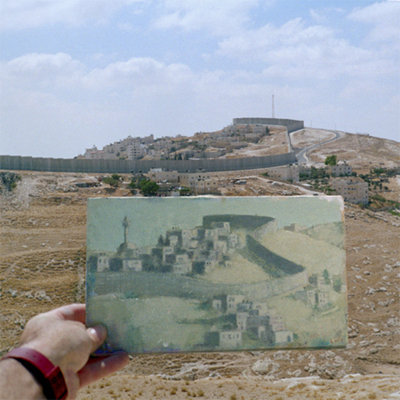Francis Alys
dal 14/2/2007 al 16/3/2007
Segnalato da
14/2/2007
Francis Alys
David Zwirner, New York
Sometimes Doing Something Poetic Can Become Political and Sometimes Doing Something Political Can Become Poetic. Thr project includes a film in collaboration with Julien Devaux as well as a map of Alys's journey, photocollages, paintings, drawings, and a group of sculptures.

Sometimes Doing Something Poetic Can Become Political...
A compulsive wanderer, Francis Alÿs is known for his in-depth projects in a wide range of media including documentary film, painting, photography, performance and video. Many of his works involve intense observation and recording of the social, cultural and economic conditions of particular places, usually conceived during walks through urban areas. For example, The Modern Procession (2002), chronicles the movement of artworks from MoMA to Queens before the remodeling and expansion of their Manhattan galleries. In Cuentos Patrióticos (1997), a flock of sheep circle the main flag pole on the Plaza del Zócalo in Mexico City as a political metaphor. Filmed in the same plaza, Zócalo (1999) records the same flag pole as it becomes an accidental sun clock over the course of a day. Some projects focus more intently on the people who live in Alÿs's subject cities. Beggars (2002-2004), comprises an 80-slide carousel with images of street people asking fo r money at the entrance to the subway in Mexico City, and When Faith Moves Mountains (2002) documents a large group of people outside the Peruvian capital as they slowly and deliberately "move" a large sand dune a short distance using shovels. In these and his many other projects, which are typically displayed along with working notes, drawings, paintings, photographs and ephemeral material employed in their processes, Alÿs creates powerfully original metaphors for human will.
Sometimes Doing Something Poetic Can Become Political and Sometimes Doing Something Political Can Become Poetic, which includes a film in collaboration with Julien Devaux as well as a map of Alÿs's journey, photocollages, paintings, drawings, and a group of sculptures, was exhibited in part at The Israel Museum in Jerusalem in 2005. The film, which revisits the artist's 1995 work entitled The Leak, shows Alÿs carrying a dripping can of green paint along the armistice boundary that Moshe Dayan marked on a map with green pencil after Israel's War of Independence ended in 1948. The piece questions the physicality and cultural relevance of the Green Line, its function as a social and spiritual division in the city of Jerusalem, and its role in the Arab-Israeli conflict.
With this work, Alÿs asks: Can an artistic intervention truly bring about an unforeseen way of thinking, or it is more a matter of creating a sensation of "meaninglessness" that shows the absurdity of the situation? Can an artistic intervention translate social tensions into narratives that in turn intervene in the imaginary landscape of a place? Can an absurd act provoke a transgression that makes you abandon the standard assumptions on the sources of conflict? Can those kinds of artistic acts bring about the possibility of change? In any case, how can art remain politically significant without assuming a doctrinal standpoint or aspiring to become social activism? For the moment, I am exploring the following axiom: Sometimes doing something poetic can become political and sometimes doing something political can become poetic.
Opening: Thursday, February 15, 6:00PM - 8:00PM
David Zwirner Gallery
525 West 19th Street - New York
Free admission



